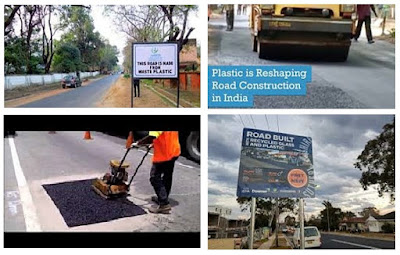A vast set of world population living in developing and under-developed countries would need no introduction to the ill-upkeep and dilapidated condition of the infrastructural roads around their respective vicinity. The vicinity could be in a rural setup, or perhaps very well in the urban setup as well unfortunately. The prime reason for such bad condition of the roads is lack of funds necessary for the upkeep of the roads and other paved areas (..and lack of funds can be attributed to multitudinous reasons world over-- a domain where we would not fathom deliberately.. LoL!)
Since quite sometime now, effective and scientific use of cheaper thermoplastics is letting the municipalities and government/ semi-government bodies to reduce their bills in the upkeep of the infrastructural setup.
Such process include use of the waste products like plastic carry bags, plastic utensils, PET bottles, and the likes that are collected from garbage dumps and junk yards accumulating disposed off things.
Plastics-- which typically are polymers of high molecular mass in the form of synthetic or semi-synthetic organic amorphous solids -- have a generic tendency to melt and wrap around things when subjected to high but controlled heating conditions. Calibrated quantum of segregated plastic waste is mixed to requisite amounts of bitumen and stone aggregates in a heating chamber, whereby the plastics melt to form an oily coat over the aggregate and the mixture is laid on the road surface somewhat like a normal tar (bituminous) road.
 |
| [Pic source(s): Various, from open web-- for quick reference purpose of our readers only] |
Worldover, the authorities have been promoting the use of plastic waste to construct asphalt roads to reduce cost of road construction and their upkeep as well as to mitigate the ever increasing nuisance value of discarded plastic waste.
Based upon the data available with The Indian Center for Plastics in the Environment (ICPE) as well as Ministry of Environment, Forests and Climate Change (MoEFCC), about 1 ton of plastic (equivalent to about 1 million plastic carry bags of 1 to 2 square feet plan area each) is utilized for laying of approximately 3,750 square meter of road surface, i.e., 1 kilometer of road surface having an average width of 3.75 meter, which makes a single way single carriage road. This results in a saving of highly costing about 1 ton of asphaltic bitumen.
The few detrimental effects of using plastic waste, viz., possible leaching, toxicity, etc. may well be mitigated using proper technology and appropriate segregation of waste at source.
To conclude, use of waste plastics for pavement making and their repairs is one of the best methods for cost-effective construction as well as easy disposal of the nuisance waste plastics.
---
Note: In case any of our Readers has a real-life experience of utilizing plastic waste in such road making/repairing process, may share their story with us, and we shall be happy to share it with all.
---
Related reference stuff from the web:


0 ||| LEAVE YOUR COMMENT:
Post a Comment
Hi! Thanks for writing-in to us. Hope we were/are able to assist you.
Your suggestions/ comments/ feedback/ contributions help us bettering our blog.
Thanks and regards,
team@bricks-n-mortar.com